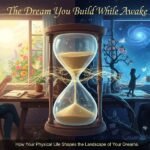Vickie Acklin AP Help, Lucid Dreaming, Meditation, Phasing Deep Relaxation
How to Create a Bridge Between the Physical and Non-Physical Mind Awake • Body Asleep
“Mind awake, body asleep” refers to a state where your body is completely relaxed and unresponsive, as if it’s asleep, while your mind remains aware and alert. This is an ideal state for practices like astral projection, lucid dreaming, or deep meditation, as it allows the practitioner to explore consciousness beyond normal waking reality.
The “mind awake, body asleep” state creates a bridge between the physical and nonphysical realms of experience. When the body is asleep, it no longer sends distracting signals to the brain, allowing the mind to focus solely on inner experiences without external interference.
In this state you can explore altered states of consciousness such as:
Astral Projection: Traveling out of body to explore nonphysical dimensions.
Lucid Dreaming: Becoming aware within a dream and controlling the dream environment.
Deep Meditation: Accessing profound inner stillness and spiritual insights.
When you achieve “mind awake, body asleep,” your body enters a state of paralysis similar to that experienced during sleep, known as sleep paralysis, but your mind remains clear. You may experience:
Vibrations: Many people report feeling vibrations throughout the body, which signal the shift to a nonphysical state.
Hypnagogic Imagery: You might see vivid colors, patterns, or even dreamlike images as your brain transitions between wakefulness and sleep.
Separation from the Body: In astral projection, you may feel like you’re floating or rising out of your body, allowing you to explore other dimensions or you may phase into a new reality and simply find yourself there.
Deep Relaxation and Focus: Even if out-of-body experiences don’t occur, achieving this state can lead to profound relaxation and enhanced mental clarity.
How to achieve “Mind Awake, Body Asleep”
1. Prepare for the Experience
• Find a Quiet Space: Choose a place where you won’t be disturbed for at least 30 minutes or more.
• Comfortable Position: Lie down in a comfortable position, preferably on your back. Make sure your head and neck are supported.
• Eliminate Distractions: Turn off electronics and dim the lights.
2. Relax the Body
• Progressive Relaxation: Start by focusing on your toes. Imagine them getting heavier and more relaxed. Slowly work your way up through your legs, torso, arms, and head. Feel each part of your body become completely relaxed.
• Slow Breathing: Breathe deeply and slowly. Focus on your breath, inhaling deeply through your nose and exhaling slowly through your mouth. This calms your nervous system and helps your body move toward sleep.
3. Mental Awareness
• Focus on Staying Awake: As your body relaxes, the challenge is keeping your mind alert. A common technique is to silently repeat a phrase like “I am awake” or “Mind awake, body asleep.”
• Visualization: Imagine every single detail of where you want to be and imagine it as there you are already there. This sets your intention and keeps your mind occupied to prevent it from drifting into sleep.
• Listen to Hypnagogic Sounds: As your body starts to fall asleep, you might hear faint noises or experience auditory hallucinations. Stay calm and observe these without reacting.
4. Watch for Signs of Sleep
• Sleep Paralysis: As you reach the “mind awake, body asleep” state, your body may enter sleep paralysis. This is a natural part of the process, and you should remain calm and aware.
• Vibrations and Sensations: You might feel vibrations or waves of energy moving through your body. These are normal and often precede an out-of-body experience.
• You may not experience any of these feelings and simply find yourself in a different reality.
5. Detach from the Physical Body
• Roll or Float Technique: To initiate an out-of-body experience, imagine yourself gently rolling to the side or floating upward. Stay relaxed and allow yourself to separate from your physical body.
• Shift Attention: Another technique is to focus on a point outside your body, like the corner of the room, and imagine yourself moving toward it.
Examples of the Process
Example 1: A person may lie down to meditate and systematically relax their entire body using progressive muscle relaxation. Once fully relaxed, they begin repeating a mantra like “I am awake” while focusing on their breath. Over time, their body becomes increasingly heavy, and they start to feel vibrations. Staying calm, they focus on floating out of their body and eventually experience an out-of-body state.
Example 2: A lucid dreamer practices by lying in bed and focusing on keeping their mind alert while watching their breath. After some time, they notice hypnagogic images forming, but instead of drifting into sleep, they hold their awareness. Eventually, their body enters sleep paralysis, and they realize they can now manipulate their dream world while fully conscious.
Mastering “mind awake, body asleep” takes practice, but there’s a shortcut! You can get into that state in minutes using one of our best selling audios – Altered States of Consciousness




